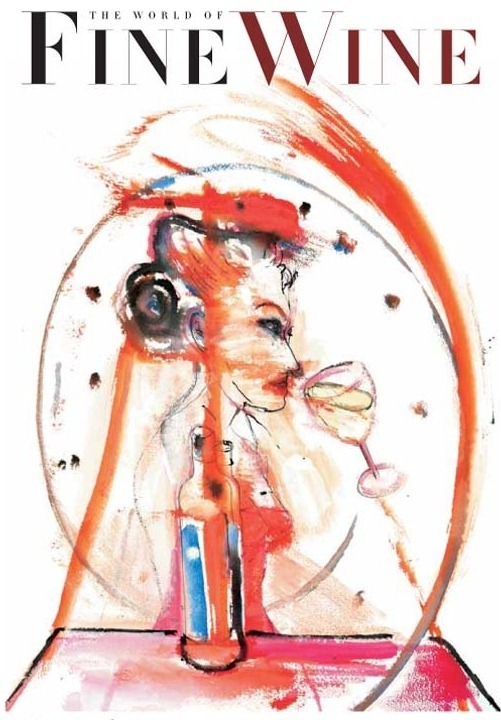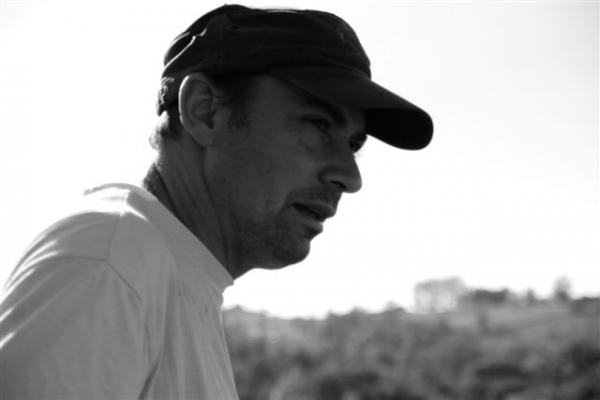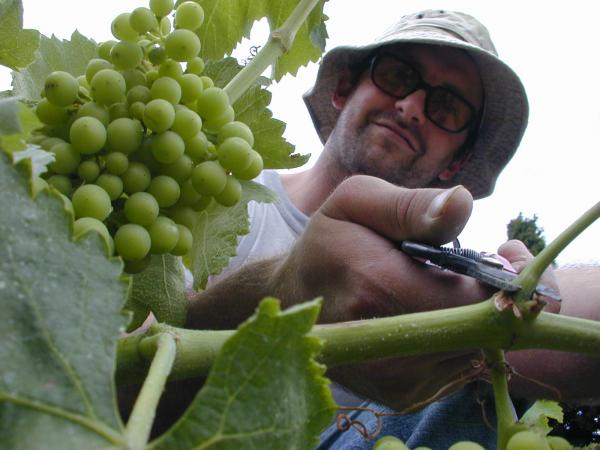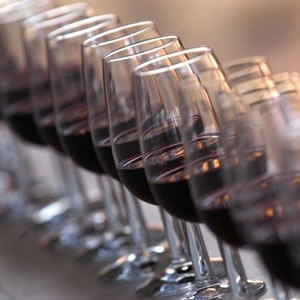
I was privileged to be invited to take part in a tasting (followed by a “round table” discussion) of natural wines at The World of Fine Wine. There comes a time when every magazine worth its sulphur dioxide (sorry, sodium chloride) must grasp the fermenting hot potato of the day. Nothing is hotter or more fermenting as a phenomenon than natural wine. Niels Bohr remarked about quantum mechanics that if it doesn’t profoundly shock you, you haven’t understood it. The wine trade regularly needs a 40,000 volt shock of natural dosage to waken from of its self-regarding torpor. Having said that lots of people are profoundly shocked by natural wine and plainly they haven’t understood it!
Natural wine as a topic invariably provokes blogger froth, wild ferment and histrionic reaction, but The World of Fine Wine is as a temple of sweet reason, with open minds rather than scepticaemia the order of the day.
It helps to arrive at a tasting with reference points to these wines, although it does skew the process of tasting. Sampling the wines is tricky because they are naturally protean. Markedly different from day to day, they also shift in the glass – and over time. You have to allow a journey wherein the various aromatic elements that make up the wine, harmonise, and a sense of the whole is established. More on that anon.

We were assaying zero-sulphur wines for the purpose of the tasting, which for some are the darkest side of the dark art of natural winemaking, and for others, so it is whispered in Gath, the Holy Grail. Perhaps in the best of all natural worlds all natural wines would be unfiltered, unfined, and sans souffre. But exactly how a wine is made is not something that can be decided in advance or to a recipe. Unlike industrial winemaking. Each year, and each wine, is different. The winemaker has to improvise. There will always be times when, however reluctantly, he/she has to intervene to prevent it from spoiling.
The twenty-odd (twenty odd?) samples were also specifically chosen to illustrate that natural wines had the wherewithal to age (that much is true). Of course one could have chosen from a wide range of soif-wines intended to be drunk pleasurably with bubbles verily winking at the rim of the glass.
Although there were some tough specimens and rough ombres in the mix, the wines were never one-dimensional – the best were fluid and yielded their personality by degrees. Mutability, in my book, is to be celebrated – glasses one to five give you a different experience as the wine moves and changes shape. Oxygen aids this process – a wine may not be oxidised if the addition of air helps it to articulate its nuances rather than rudely terminates the fruit. Oxidative winemaking is fundamental to many (but not all) of these wines – it serves as a kind of inoculation as long as it does not tip the wine over the edge.
I have written before fairly extensively about the faults/flaws argument and how what some consider beautiful others often find beastly. And vice versa. The subjectivity in tasting was (I’m sure) reflected in the marks given by the tasters – and here is where the marking system becomes the pure extension of personal taste. When tasters attribute their low scores to one or more intrinsic faults in the wine (the very fault or faults that might be celebrated by another taster)… well, then, things fall apart, the centre cannot hold and what was known becomes naturally unknowable. The wines are dangerous thus. They are out there and so they are available to be appreciated by a large number of independent-minded individuals. This assertion of the primacy of opinion challenges of the most basic taste consensus. For me this tireless dissent is cherishable, it creates an energetic dialogue and to use a modern cliché, it moves the goalposts.
Remove all that is potentially obnoxious and you remove everything that is potentially alive. Safety nets in winemaking are one thing, mummifying the wines is another. Too much is made of wine faults by critics who pass rhadamanthine judgement with the unblinking certainty of one whose palate has been charged higher purpose. The enjoyment of natural wine seems to be interpreted as an implicit criticism of all other wines rather than the simple expression of preference.

Here’s the thing: for a long time, these wines were misunderstood. There were so many “connaisseurs” that believed our wines weren’t good because they were unfiltered, un-fined, un-everything… Today, people are more sincere when they drink. They taste a wine, and if they like it, they’re happy. They are much more confident in their own palates. Better that than being told what you should and shouldn’t like! So I think there is a future for these wines. I think that one day we won’t talk about organic agriculture anymore, because everyone will be doing it.
-Emmanuel Houillon
Summary
A tasting is a snapshot of how the wines are drinking at a given moment as well as the preferences of the tasters themselves. I am happy to admit that I respond to these wines – I also look for certain things, I expect surprises, I recalibrate constantly and I try not to compartmentalise or judge too strictly. The wines deserve it; I can’t remember a tasting where I returned to the wines over and again to suck their very marrow. Would I do this in a tasting of conventionally-made wines? Probably not – if you taste something that is square, unyielding and monolithic you know the wine has given what it has got, for better, and usually for worse.
We tried wines from Italy, Spain and France; we sampled oxidative whites, wines made with skin contact and in amphorae, wines from hot and cool climates and a melange of grapes and terroirs.
Isabelle Legeron placed the idea of natural winemaking in its truest context. It is important to do this as we too often obsess about product as targeted at hypothetical critics and consumers rather the producer and fixate about trends and movements. Much natural winemaking is part of a lifestyle that most of us have little notion of – such as living on a farm with your own sheep and cows and making your own bread, butter, cheese, sausage and wine. The idea that you might make a wine for yourself (and your friends) is so simple that is revolutionary, or that the primary function of wine (pace Jacques Neauport) is to be drinkable rather than polished. And, above all, to be honest. We are so accustomed to qualitative assessment that we lose the fundamental truth.
(This is with the obvious rider that not all natural wines are immediately drinkable [or ever drinkable], and some are not good at all, but generally they possess certain qualities that I [and thousands of others] find aesthetically appealing.)
Someone suggested that the by-products of natural winemaking obviate terroir expression. One could say that the transformative results of fermentation affect or inflect the terroir expression. Natural winemaking is a better vehicle for terroir transmission than more interventionist winemaking which prizes stability above singularity and builds denaturing of the wine into the recipe. Of course, there is a balance to be found and a certain clarity of articulation, but terroir expression can only come from amazing grapes and sensitive process.
I look for the following qualities in natural wines or rather I find these to be natural qualities in the wines I like.

Tension & energy –A flickering nerve, a coiled spring, the fluidic arc, the force that pulls the wine across the palate. The energy is an inherent or self-sufficient property of the wine as if the wine possesses its own natural life.
Lines – related to above – that chiselled quality that keeps the wine mean, lean and clean. Linear wines have no blubber, no padding, they do not fill out the mouth, but their carry the DNA from a to b in the straightest line possible.
Acid and malolactic – as someone who carries a lemon to finish his dishes I am not averse to pucker-wines and jolting sharpness.
Oxidative –as opposed to oxidised. Some conflate these two words and say NO2 O2. As we know oxygen is a tool in the winemaker’s kit conferring further (secondary) aromatic flavours such as nuts, honey, balsam and toast.
Rawness – some of the reds had a coarse texture like rough tweed, a palpable astringency. For all that they seemed more real for being less polished.
Minerals – A textural crunch, a (mineral) salty finish that lengthens and defines the wine.

Minerality in wine is not for me a specific note but a sensory experience that is thrilling to the palate and beyond. Minerality in a wine is something that can be perceived, if not described, by the average drinker. It cannot be described by the average writer. I have heard so many people say “I love that salty finish that makes me want to drink more ….” This is usually said with a big smile. As a wine-maker (sorry) vigneron that is enough of a description of minerality for me.
-Tom Lubbe, Domaine Matassa
The exalted impression of one characteristic is often due to the reduction of impediments. Terroir can be tricked out of a wine, the result of a systemic denaturing process. Minerality is the very backbone, the seam of a great wine; it binds the whole, it brings focus and clarity, it signifies the migration of the life of the soil into the soul of the wine.
Wines with these qualities have an authentic style, a distinctive accent. They may be beautiful or rude, but they are honest to a fault – or a flaw. To me wine, real wine, is what it is, the sum of its parts that have been left in and unaltered.
In conclusion…
… interesting wine befuddles the senses (and scrambles common sense) and not because of the ingestion of alcohol.
A group of tasters are locked into likes and dislikes. What I might find a distinguishing characteristic another might characterise (or caricature) as a fault. And this leads to fundamental MARKS-SCHISM. In the end some awarded 4s and 5s to wines whereas others had given them 18s and 19s. Here are the points are truly pointless, because we could just as easily flip the scenario, taste a bunch of conventionally-made and the marks would yo-yo accordingly.

De Martino’s journey from making over-ripe confected alcoholic wines to elegant, relaxed gastronomic styles shows that received wisdom is a hot dogma with no real meat in it. Marcel Lapierre in Morgon wanted to make wines that he could drink and so abandoned the sulphur-first approach. In the end they went back to basics, relied on intuition and taste, rather than quick (and often quack) fix technological solutions and got closer to their wines.
One brief illustrative story. I very much enjoyed one of the wines at the tasting from a grower that I knew well. A couple of weeks previously I had been in his vineyard and witnessed how he worked and began understand the rationale behind each of his winemaking choices. He knew his grapes and he knew where he wanted the wine to be in terms of its shape, structure and overall identity. When he tasted his wines he was looking for that feeling of satisfaction that you get when the wine turns out as it should.

As drinkers we are allowed our taste, as wine critics we need to taste with humility and not presume to know best. The trouble is that if you undermine normative hierarchical standards by giving equal credence to the opinion of the enthusiastic amateur as to the seasoned master of wine, if you allow that, one might make greater wine with no additives in a garden shed and sans fanfare than the winery with its battery of bristling modern equipment, professional oenologists and budget blown on hype. If you examine what is done in the name of viticulture that has a detrimental environment effect or what is added to wine that has an adverse effect on health, then truly doth the baby beat the nurse and quite athwart goes all decorum.
The natural winemaker is the man or woman who makes additive free wine for themselves, rather than the supermarket, the critic or posterity. All the wines at the tasting vaulted the earthbound necessity of points, some would make your heart sing, others would make you furrow your brow, but straight or strange, they were unified by their originality and, for want of a better word, their realness.

